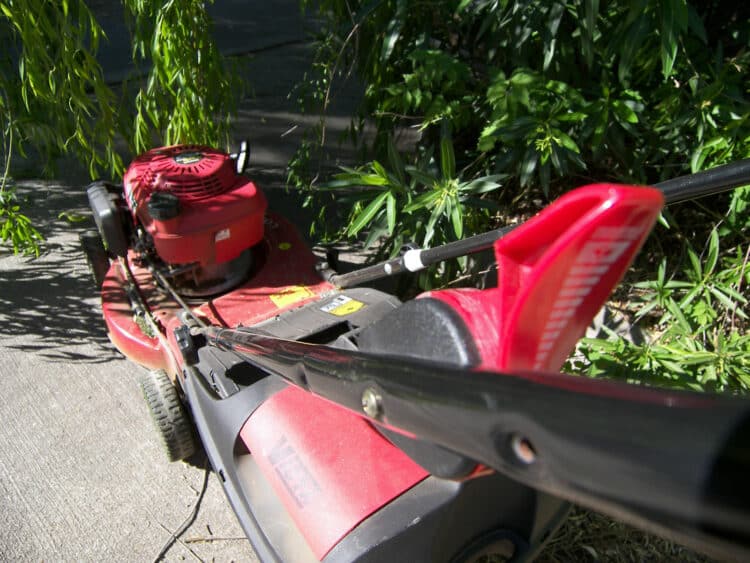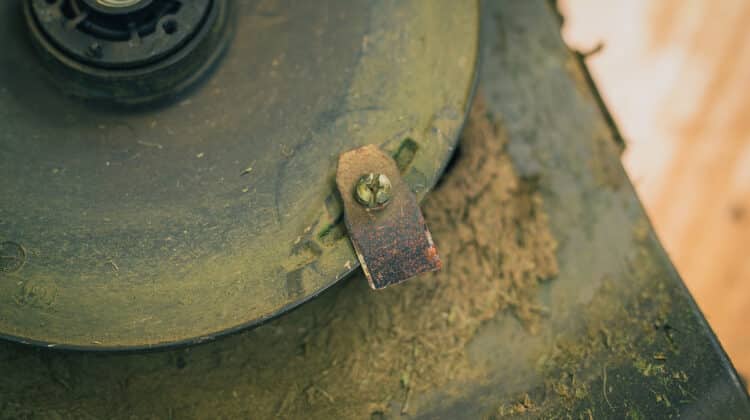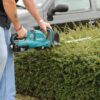
Do you want to learn how to sharpen lawn mower blades without sharpening them?
You will need the blades of your lawnmower to be sharp, and thus it will be effective in cutting grass on your lawn.
This way, you can cut it quicker and cleaner, thus enabling you to have a beautifully trimmed and healthier lawn.
Your lawn would less likely be infested with diseases and pests if the grass is cut with a sharp blade.
Before learning about the various methods in sharpening lawn mower blades, there are a few other details that are as important, like:
Table of Contents
What Are The Different Kinds Of Mower Blades?
Lawnmower blades are an essential component of a lawnmower, and they might be the most important. Without it, you cannot cut the grass, which is what mowers are supposed to do.
Here are the various kinds of lawnmower blades:
High Lift Lawn Mower Blades
High lift blades have an exaggerated fin at the non-mowing edge side, which enables them to create a higher-than-usual lift.
High lift blades are utilized for:
- In cutting tall grass over three inches tall
- In cutting thin grass like the tall fescue
However, do not use high lift blades for:
- In areas with lots of sand
Low Lift Lawn Mower Blades
Low lift blades have an exaggerated fin at the non-mowing edge side, which enables them to create a lower-than-usual lift compared to high lift blades.
Low lift blades are utilized for:
- In cutting short grass below three inches tall
- In cutting inflexible grass like Bermuda grass
- In sandy soil
However, do not use low lift blades for:
- In cutting grass more than three and-a-half feet tall
Gator Blades
Gator blades are also known as three-in-one blades, which are utilized by mowing companies. They use it when the autumn season comes, wherein they can shred the fallen leaves as they cut grass.
Gator blades are utilized for:
- In cutting overgrown grass
- During autumn
However, gator blades are not used for:
- In sandy soil
Mulching Blades
As the name suggests, mulching blades mulch grass cuttings to enable them to return to the soil as fertilizing nutrients.
Also, you can do the task of mulching without the mulching blades by disseminating the grass trimmings, from the mower deck and into the yard manually. You can do this as long you are frequently mowing your lawn.
Mulching blades are utilized for:
- If you are not disseminating the bagging or the grass trimmings
- If you are not adhering to the one-third rule, wherein you are cutting one one-third of the grass whenever you are mowing
However, gator blades are not utilized for:
- In cutting overgrown grass
- Whenever disseminating or bagging the grass trimmings
Flat Lawn Mower Blades
As the name implies, the blades are flat, thus creating no lift.
Flat blades are utilized for:
- In cutting rigid grass
- In sandy soil
However, flat blades are not utilized for:
- In normal lawn conditions except both instances above
Self-Sharpening Lawn Mower Blades
These are new types of blades, which will make themselves sharp as you mow. These are also expensive, which you should think about before selecting appropriate mower blades for your yard.
When Should You Sharpen Your Lawnmower Blades?
Many factors can determine when you will need to sharpen your mower blades, like the kind of grass you’ll be cutting, its length, the soil conditions, and many more.
It also depends on how often you are using the mower. As a rule, after using it for more than twenty hours, the blades need to be sharpened.
For instance, if you have an expansive lawn that takes one hour to finish cutting, you will need to sharpen the blades after twenty uses.
A smaller lawn that takes about thirty minutes to mow will need to be sharpened after forty times using it.
The best way to find out when you will need to make them sharp is to look at the quality of the clippings, the sharpness of the grass cut from your blades.
If you see that the grass has not been cut properly and torn from the ground, it needs cutting.
Generally, the more often you use it to cut grass, the more you need to sharpen the blades.
FYI: The best practice that you can follow is to examine the blades before and after using them to update yourself on their condition.
How To Tell If The Lawnmower Blades Have Been Sharpened Too Many Times?
The best way to find out the answer is to read the manufacturer’s manuals. They will recommend replacing the blades when they are one and one-half inches left between the cutting edge and the lift, fin, or sail.
The sail, lift, or fin refers to the blade component that is on an upward angle.
If you still resume mowing even though the blades remaining are less than one-half inch material left, it will become a potential risk. If you use it in this condition, the blades cannot cut and might send a piece of its blade hurling from the mower.
If you find your lawnmower blades in this state, either sharpen them immediately or replace them.
When Should You Replace Lawnmower Blades?
As time passes and you constantly use your lawnmower to cut the grass on your lawn, there will come a time when the blades cannot be sharpened anymore and have to be substituted.
At this stage, the blades have been sharpened too many times, and too much of the blade materials have been removed.
Another reason is the blades have been bent.
Do not try to bend it back and reuse it since its integrity is already gone when it was bent out of shape.
Another reason is some portions of the blade are chipped and missing from hitting a hard object. When this happens, inspect it immediately to check if you can still use it or if they are too damaged has to be replaced.
Should You Sharpen Both Sides Of A Mower Blade?
No, only one side should be sharp, and the other side isn’t. A typical mower blade should have a sharpened edge at about a forty-five-degree angle, and the other side remains rough and dull.
If you make your mower blades sharp on both sides, they will become dull quickly and need constant sharpening.
How Sharp Should The Mower Blades Be?
Lawnmower blades are not knives that should be sharp at all times to remain effective. They only need to be sharp enough to cut grass evenly.
You do not need to make it too sharp, and once they are sharp enough to cut grass, halt the sharpening procedure.
How To Sharpen Mower Blades Without Removing?
Whenever mowing season arrives, your lawn has to be trimmed, and you need to breathe life into your long-dormant lawnmower once again.
A lawnmower is one of the most essential tools in lawn care and maintenance. It should always have sharp blades to be able to cut the lawn grass properly.
But some homeowners have less time to care for their lawn and want to do it quickly and efficiently. Removing the lawnmower blades and sharpening them would cost a lot of time.
Sharp lawn mower blades are a must and should be done before you start mowing again.
Here is an abridged version of the necessary steps in sharpening lawn mower blades without removing them:
- Assemble the necessary tools.
- For an electric lawnmower, take out the power cord. For a gas-powered one, seal the fuel tank.
- Tilt the lawnmower and put a wooden or cement block beneath it to provide support. Make sure that the blades are facing you when you do the sharpening procedure.
- Use a steel brush and water to clean the blades.
- Use a flat file or an angle grinder to sharpen the edges of the blades.
- Take out the supports and set the mower down.
- Unseal the fuel tank.
Now you know the steps in condensed form. Yet you still have to know the complete step-by-step process below:
1. Preparing to sharpen the blades
Before doing the sharpening process with your mower blade, you will need the get the proper tools and also follow safety procedures.
- Wooden or cement block
- Bucket of water
- Steel wire brush
- Putty knife
- flat file or an angle grinder
- Thick work gloves
- Safety goggles
Bring your lawnmower to an open space with an even surface.
Once there, remove the spark plug to prevent accidental switch-on and make sure that its parking brakes are on.
2. Switch off the power and seal the fuel tank
At this stage, you will need to seal the fuel tank completely to avoid letting the gasoline spill out since the mower has to be tilted.
Unscrew the lid of the gas tank, put a plastic bag on top, and screw it back on tightly. The plastic will block out any possible spills whenever the mower will be tilted.
If you are using an electric lawnmower, be sure it is not plugged into an electrical outlet.
3. Tilting the mower
You will need to incline the mower sideways to gain access to the blades. In doing this, make sure that the carburetor and fuel tank are not overturned and remain on top.
Take a big enough cement or wooden block and place it diagonally in a stable position underneath the mower to provide support. Check for its stability and if it is still wobbly, make some adjustments before beginning the sharpening task.
4. Restrict the movement of the blades
After making sure that the mower is stable and secure, you need to do the same thing to the blades. You have to restrain them in place since you have to safely sharpen them.
5. Clean the blades
Before sharpening the blades, you have to clean them first to make the ensuing task easier. Fill up a bucket with water, take a steel wire brush, putty knife and proceed to clean the mower blades.
Since you are on dirt removal duty, why not clean below the mower deck? It will make your lawn mowing chores easier later.
6. Sharpen the blades
The steps before were the preparation stages, and now you will be doing the main task of sharpening the mower blades.
You can choose from either sharpening tools: an electric grinder or metal file, which will be easier and more comfortable for you.
Having the lawnmower tilted affords you to sharpen the blades at the right angle and proceed to sharpen them.
After finishing one side, then sharpen another, and so forth. Always check for the stability of the mower to avoid further accidents.
Take your time sharpening the mower blades, and make sure you are moving the grinder or file in one direction on the top face.
Use the whole length of the file or grinder in every stroke. Rather than going for speed, move deliberately and smoothly.
Try to angle the file or grinder at forty-five degrees on the top edge of the blade for even sharpening.
7. Unseal the tank
After making sure that each of the blades is sharp and fit to cut grass, slowly lower down the mower.
Remove the plastic seal from the fuel tank opening, re-cap it, and turn the mower back on.
Or, in case you have an electric mower, plug it back on the electrical socket. You are now able to use your mower that now has sharp blades.
Important Reminders
Here are some necessary tips that you should keep in mind before sharpening your mower blades:
- To avoid any potential accidents, empty your mower’s gas tank first before sharpening the blades. This way, no spills, leaks, or further injuries will happen.
- Remain attentive to the condition of your mower blades. Make regular inspections to check its sharpness or dullness.
Check the grass after mowing if it is cut sharply and evenly, or if it is torn from the ground or has split tips. - If you notice that the blades are bent, unbalanced, too jagged, then they need to be substituted with new ones.
If the blades reach this stage, they could not be sharpened anymore, and any attempts of sharpening or fixing them will not work. - If the mower blades are slightly notched, they are not useless. You can still sharpen them up and use them for cutting your yard.
But if they are too jagged, the uneven edges too pronounced, then you can do anything about it, and it has to be replaced. - Your mower blades should be properly balanced. If you hear strange sounds emanating from the blades upon using it, it means its balance is off.
It is also one indication that the blades need to be sharpened if they are not properly balanced.
Conclusion
Now you have learned how to sharpen lawn mower blades without removing them. And yes, it is possible to make them sharp without taking them out from the mower.
Follow the steps mentioned and avoid the fuss of removing the blades just to sharpen them. This way, you can make them sharp efficiently and easily.
Once mowing season arrives, you can cut the grass on your lawn with much fervor and be the envy of your neighborhood.





